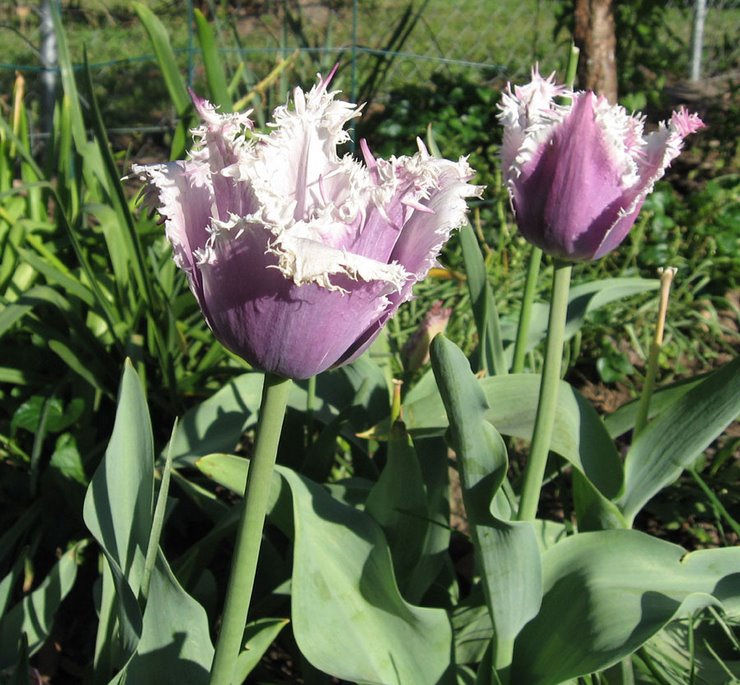Spring is such a great time in the garden, and I'm thoroughly enjoying it. However, it's also a time when my allergies kick in, so there are things that I do to keep them from taking all the fun out of the season.
There are lots of suggestions out there of ways to prevent or lessen allergic reactions. I've collected a lot of them from my allergist, books, articles and websites. From these, I've found those that help me the most. Which approaches are best for a particular person depends on exactly what things you are allergic to, and how you are exposed to them--by inhaling, touching or ingesting the allergens. In gardening, allergens include pollen from plants, mold spores, and contact reactions from plant sap.
Many allergic people I know don't try to change their gardening habits to lessen reactions; they simply take medicines to control symptoms. They feel that since pollen will blow over from surrounding yards, and can travel for miles, that there is no point in even trying to do anything preventive.
I have learned a lot about dealing with pollen from books and articles by Thomas Ogren. He says that research shows that the closer we are to a highly allergenic,
high-pollen plant, the greater our exposure will be. A high pollen tree in your own yard will expose you to ten times the pollen than would a similar tree planted down the block. Think of it like second-hand smoke. If you are standing next to a smoker, you get an overwhelming dose of smoke; whereas if the smoker is across a large room, you still smell it, but it is less likely to make you ill.
Here are some of the main things I do to try to keep my gardening low-allergy.
1) One of the basic things I can do to cut the pollen I inhale is to remove from my yard plants whose pollen is wind-borne, and replace them with plants that are insect-pollinated. How do you know which plants are which? In general, insect-pollinated flowers will be the brightly-colored ones. Tube-shaped or enclosed flowers like snapdragons or lavendar tend to be safer. Before I buy new plants, I check Ogren's list, to find which plants are the best choices. (See the link to the OPALS list.)
2) Know if it's a high-risk day for you, so you can take extra
precautions. Do your allergies kick up primarily in the spring, summer
or fall? Check websites that will give the pollen count in your area.
Windy days can mean a lot of pollen blowing around. Mornings are often
the time when pollen is worst; between 5 and 10 a.m. in particular.
During high-pollen times, it may be best to wait until later in the day
to be outdoors.
3) Clean off the pollen and mold spores once
you come back inside, so that you don't continue to expose yourself to
the allergens. Pollen will cling to your hair and clothes, and will be
brought back into your house with you. During high-pollen times, I cover
my hair before I go out with a scarf. Don't rub your face or your eyes during
gardening. When I go back inside, I immediately change clothes, and dump
those clothes and hair scarf in the wash. I wash my hands and face,
then do a sinus rinse.
4) Weeds are far more often the source of problem pollen, rather than cultivated garden plants. It pays to stay on top of weeding!
5) Diversity is good. By having a variety of different plants, with different bloom times, you don't
have a huge amount of any one kind of pollen being produced at the same
time.
6) Keep the lawn mowed. A lawn kept 2 - 2 1/2 inches high is less likely to to go to seed, and is also less likely to hold blown pollen than a shaggy, over-grown lawn. Reduce lawn areas, and replace them with groundcovers such as ajuga, periwinkle or creeping thyme.
7) Avoid organic mulches like bark or straw, as they break down, particularly if damp, and release mold spores. I use gravel mulch, or groundcovers as much as possible. Ground cover plants are generally a better choice than bark mulch to avoid mold or blowing dust.
8) Be careful with your compost. Composting is a mold process. When you turn your compost, mold spores are thrown into the air. I got rid of my more open compost container made of chicken wire, and switched to a closed compost container. When I turn the compost or take it out, I always wash my hands and face as soon as I am done. It is also helpful to wear a mask and cover my hair.
9) Be careful about using herbicides, insecticides and fungicides. Over-exposure to these substances can lead to the breakdown of the immune system. This is true of pets as well as humans.
10) Keep your plants healthy. Plant diseases like rust, black spot or mildew give off spores, and may cause reactions. Know your climate zone, and check to be sure the plants you are considering can thrive where you live. Choose the location of your plant carefully so it has the right light level to do its best.
Making just a few of these changes can help ease those allergy symptoms. With some experimentation, you can find what will allow you to garden more comfortably.

3 comments:
I've gotta check out this OPALS list. Never heard of it before!
I like the idea of stuff I can do besides just pop pills (and blow my nose LOL!)
I'm glad to see there's stuff I can do that might make a difference. My hay fever and allergies are getting a lot worse, but I sure hate to give up my garden.
Post a Comment